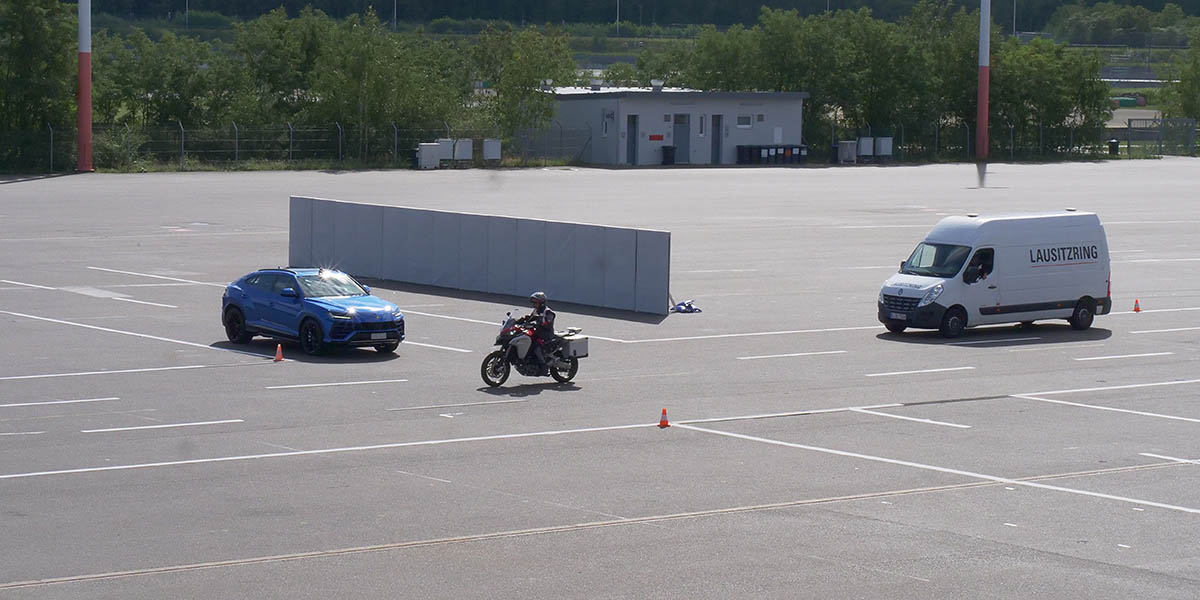The Connected Motorcycle Consortium demonstrates new technology for improved rider safety
Jan. 9, 2024 (Story from December edition of American Motorcyclist)
By Keaton Maisano
Most motorcyclists know this, and study after study have confirmed it, but it bears repeating, as it affects street riders just about every time they climb aboard a motorcycle: The most dangerous place to be on the street is an intersection, and the biggest cause of two-vehicle crashes (and a huge chunk of motorcyclist fatalities) is a vehicle turning left into the motorcycle’s path.
Whether from negligence or vision issues or the physical size of the motorcycle or a lack of headlight or excess speed on the part of the rider or any one of several other factors, the intersection and the left-turning vehicle are a lethal combination.
But what if technology was able to cancel this substantial threat to a motorcyclist’s well-being?
Well, that’s a reality the Connected Motorcycle Consortium (CMC) is trying to create. The CMC is a collaboration between manufacturers, suppliers, researchers and associations to make motorcycles and powered scooters part of the future connected mobility.
The non-profit organization was established by key motorcycle makers — BMW Motorrad, Honda and Yamaha — in 2016 to develop Cooperative Intelligent Transport Systems (C-ITS) and Advanced Driver Assistance Systems (ADAS) that increase the safety for those riding motorcycles and scooters. With previous technology being developed without motorcycle-specific safety aspects in mind, the CMC’s goal is to make sure motorcycles are part of C-ITS and connected mobility.
All efforts fit under the CMC’s goal of digital conspicuity, which involves the recognition of motorcycles and other powered two-wheelers by means of exchanging messages with other vehicles. This action ensures drivers are aware of motorcycles in the vicinity, thus reducing dangerous situations and bad outcomes.
To showcase the progress made in the past seven years and across its first two phases of development, the CMC performed a demonstration of its technology Sept. 14-15 in Germany.
The demo event tested C-ITS features that aim to help motorcycles and cars communicate with one another and cut down on accidents — such as ones caused by the dreaded left-turn situation. ADAS features — which use camera, radar and lidar to sense motorcycles — were also used to show its capabilities in preventing crashes with motorcycles.
Throughout the demonstration — which included features such as Left Turn Assist (LTA) and Do Not Pass Warning (DNPW) — the CMC showed how an early exchange of information can prevent dangerous situations that have plagued motorcyclists.
For example, the demo presented the classic situation: a car turning left to cross over a lane occupied by a motorcycle. Instead of solely relying on the driver’s ability to see the motorcycle clearly — which can fail because of the driver simply missing the motorcyclist or by way of an obstructed view — C-ITS presents the driver with an alert that makes a noise and shows the motorcycle’s positioning on the car’s display.
This alert works similarly for motorcycles with a display, detecting stationary or turning cars that may pose a threat to a motorcyclist. Even motorcycles without displays could benefit from the technology based on the demo, which showed a small sender that could be fitted to a motorcycle. This sender informed other vehicles of a motorcycle’s whereabouts in each scenario throughout the tests, making the motorcyclists safe from other drivers who might not see them.
While this all remains in the testing phase and an ocean away, the demo is proof that progress is being made toward increasing the safety for motorcyclists on the road. This directly combats a trend of autonomous-vehicle development that fails to include motorcyclists in its testing, creating potentially dangerous situations for motorcyclists on the road.
The CMC moves into its third phase in 2024. This next step includes further research on key factors that will help reduce motorcycle accidents.
In addition, the CMC will revisit and revise its “Basic Specification” — a combination of research, tests, guidelines and more formed in 2020 to help motorcycles connect and “talk the same language” with other vehicles and infrastructure by means of wireless communications — as a result of further learnings and development.
The CMC foresees cooperation with infrastructure stakeholders and continued collaboration with vehicle makers as the project nears deployment.
To learn more and watch videos from the demonstration, visit www.cmc-info.net.






